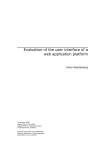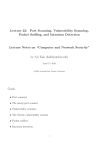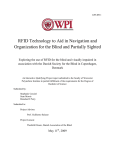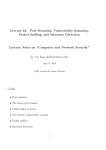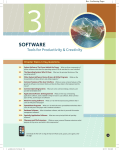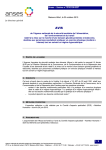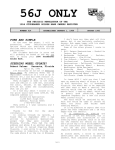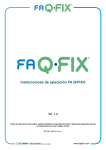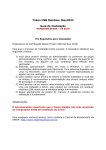Download Capital Letter - STC: Washington, DC Chapter
Transcript
July/August 2004, Vol. 40, No. 1 CAPITAL LETTER In this Issue Daily’s Dish: Letter from the Editor . . . . . . . . . . 2 From the President . . . . . . . . . . . . . . . . . . . . . . . . 3 Chapter Chatter. . . . . . . . . . . . . . . . . . . . . . . . . . . 4 Articles: How To Stay Hot When Your Java Gets Cold . . 1 Content Management vs. Document Management: The Difference is Granularity . . . . . . . . . . . . . . . 7 SIGs Revealed . . . . . . . . . . . . . . . . . . . . . . . . . . 9 The Independent Voice. . . . . . . . . . . . . . . . . . . 11 Rave Reviews . . . . . . . . . . . . . . . . . . . . . . . . . . 12 Managing Enterprise Content: A Unified Content Strategy, by Ann Rockley . . . . . . . . . . . . . . 12 Writing Great Content Within a Content Management System. . . . . . . . . . . . . . . . . . 14 Telecommuting . . . . . . . . . . . . . . . . . . . . . . . . . 16 Quotable Quote: “The skill of writing is to create a context in which other people can think.” – Edwin Schlossberg How To Stay Hot When Your Java Gets Cold by Conni Evans, Senior Member If you’re trying to keep abreast of the latest trends affecting the workplace, you’ll find that the trends are becoming decidedly non-technical. Technology is always a topic of conversation, but so are the economy, healthcare, and war. Security and compliance issues impact almost every person in nearly every organization. Ask human resources professionals for advice on what employers are looking for, and technology skills are not anywhere near the top of their list. In fact, in some cases, technology tools don’t even appear on the list. Things like initiative, compatibility, leadership, integrity, and even social interests and involvement are employers’ hot buttons. 1 Sure, Java is a hot skill to have. But technical jargon like XML, VoIP, and Wi-Fi is like “sci-fi” to many hiring managers. Technical skills can be taught; integrity and a positive attitude cannot. Thinking and reasoning skills are applicable in any job and therefore marketable in a variety of industries. As a technical writer, these higher-level aptitudes are critical to the way you do your work. You’re used to transforming yourself into a user when you write software documentation. You “become” a developer as (Continued on page 7) CAPITAL LETTER 1 Daily’s Dish: Letter from the Editor Pam Daily July/August 2004, Vol. 40, No. 1 Creating and supporting a forum for communities of practice in the profession of technical communication S o c i e t y f o r Te c h n i c a l Communication (STC) 901 North Stuart Street, Suite 904 Arlington, VA 22203-1822 Phone 703-522-4114 http://www.stc.org Region 2 http://www.stcregion.org/region2/ index.shtml Wa s h i n g t o n , D C C h a p t e r P.O. Box 14125 Silver Spring, MD 20911 http://www.stcwdc.org/ S T C Wa s h i n g t o n , D C Chapter Capital Letter Managing Editor Kathy Bell [email protected] Production Manager Bobbie Dofflemyer [email protected] Copy Editor David Dick [email protected] Advisor Carolyn Kelley Klinger [email protected] The Capital Letter is published six times per year by the Washington, DC Chapter of the Society for Technical Communication. Its purpose is to provide articles and essays in the field of technical communication as well as inform chapter members about special functions and regular activities of the chapter and Society. Material for publication should be submitted to the editor: Kathy Bell at [email protected] This newsletter invites writers to submit articles that they wish to be considered for publication. Note: By submitting an article, you implicitly grant a license to this newsletter to run the article and for other STC publications to reprint it without permission. Copyright is held by the writer. In your cover letter, please let the editor know if this article has run elsewhere, and if it has been submitted for consideration to other publications. The design and layout of this newsletter are copyright STC 2004. 2 Daily’s Dish: Letter from the Editor Pam Daily Since this is my last official Letter From the Editor, I would like to acknowledge those who have been a very important part of this newsletter committee. First, I want to thank all those individuals I have worked with during the past two years. I have learned so much and I am finally seeing all my ideas come to life, especially the variety of great columns we have in every issue. I want to thank Kathy Bell for being my Copy Editor and stepping up as Managing Editor. Kathy, you have taken on my baby and I have all the confidence that you will continue to build on the great things this newsletter has to offer the members of STC. Bobbie Dofflemyer, I appreciate all of your attention to the beautifully detailed layout of this newsletter and for making our HTML visions come to life. Keep up the great work! Jennifer Reed, you have contributed so many great things to this newsletter. You always make sure we have some visuals to add to the mix. And I thank you for bringing our SIGs Revealed column to our readers. It is very informative and I love that you have so many ideas and information to share. Patricia Srinath, I absolutely love all your wisdom that you bring into the Telecommuting column and I thank you for all your great articles. David Dick, all the way from Belgium, with all your support and commitment, it feels like you are here. Thank you for always having a book review lined up for the Rave Reviews column. And now, I especially want to thank my mentor, Carolyn Kelley Klinger for being there for me since day one. Carolyn, you somehow made me see the strength in myself to take on the newsletter when I thought I could not bring it to new levels. You inspired me in so many ways. I sincerely thank you for guiding me and showing me the freedom and self-confidence to bring my vision forward. I also have learned that I am not alone in this feeling of gratitude. You are truly a gem to so many of us and I hope you know that we all appreciate the time you have given each of us individually, making us feel that we have a special connection with you that no one else could have. If I could create an award of recognition for you, it would be the INSPIRING GEM AWARD. I would also like to thank all of our contributors, both past and present. We couldn’t have done it without you. And of course, I also thank our readers and members alike, who we do it all for. I truly enjoy being a part of this newsletter team. It is a great creative outlet for me and has proven to be something I cherish and look forward to reading. And although Kathy Bell will be taking my place as Managing Editor, I will still be a part of team. I look forward to all the great ideas that Kathy has in store for the Capital Letter. “At times our own light goes out and is rekindled by a spark from another person. Each of us has cause to think with deep gratitude of those who have lighted the flame within us.” – Albert Schweitzer CAPITAL LETTER From the President July/August 2004, Vol. 40, No. 1 Kathy Bine From the President Chapter Leadership Kathy Bine I'm grateful for technology, in part because thanks to the World Wide Web you were able to vote in your STC chapter’s elections. That’s how I came to write this column, and I’m grateful to every one of you who voted. Technology infuses our lives in many subtle ways. After Hurricane Isabelle last year, I realized that I’ve become so spoiled by appliances that I can barely work without a cup of hot caffeinated beverage. After 16 hours without electricity, half of those spent asleep, I was ready for my hot water heater, stove, fans, and radio to work again. Information technology overwhelms our lives at times, too. Electronic mail, voice mail, cell phones, DVDs, and personal digital assistants sometimes seem like less-appealing versions of the Tamagotchi, the Japanese keychain toy that demands you feed, play, and clean up after an electronic pet. In the job market, it’s easy to think that “if I learn Framemaker/InDesign/Cold Fusion everything will be better.” The problem is that today’s must-have tool is quickly superseded by something different. problems even as they provide amazing solutions. Technology’s effects are astounding. In the past 10 years, I’ve gone from using an array of software tools (Photoshop, Visio, Word, RoboHELP, at least four website development tools) to using an array of communication tools (Outlook, webbased email systems, Microsoft Instant Messenger, Yahoo! Instant Messenger, Microsoft Sharepoint portals to check, Lotus Quickplaces to check, five Yahoo! Groups, a VOIP telephone with voice mail that appears in Outlook, a Handspring and a cell phone). My job has gotten easier, while the collaboration seems to be the continuing significant challenge. Is this occurring because my time is more expensive? Because I’m more experienced? Or is the industry itself changing? I’d like to think it’s because I plan. I work desperately to stay informed about the information technology industry, which helps me update that plan on a continuing basis. I focus on professional development, and I network within my company and outside it. I try to make my perspective part of the strategy for projects, not just a commodity. Part of that solution is STC and my involvement in the local chapter and While computer technology is taking special interest groups (SIGs). My over our time and wallets, other goal is always to ensure that technologies-genetics and gene technology improves the quality of my therapy, materials engineering, work and my life. Perhaps that will be cryptography-confront us with ethical the next big technology trend: having the guts to say No to the Blackberry, so that we can Enjoy Some STC 51st Annual Conference Photos focus on what we http://img72.photobucket.com/albums/v218/AmandaCross/ do well. STC%20Conference%202004/ CAPITAL LETTER President Kathy Bine [email protected] First Vice President Melissa Brown [email protected] Second Vice President Kristen Sweet [email protected] Secretary Eddie VanArsdall [email protected] Treasurer Dave Wright [email protected] Immediate Past President Daree Allen-Woodard [email protected] Region 2 Director-Sponsor Vici Koster-Lenhardt [email protected] Committee Managers Competitions Melissa Brown [email protected] Employment Ann Ray [email protected] Events/Knowledge University Kristen Sweet [email protected] History Harold Hofstad [email protected] Membership Laura Jackel [email protected] Newsletter Kathy Bell [email protected] Nominations Mike Cleary [email protected] Public Relations Denise Joseph [email protected] Speaker’s Bureau/Webmaster Cynthia Lockley [email protected] Strategic Planning Janet F. Scharp [email protected] 3 Chapter Chatter July/August 2004, Vol. 40, No. 1 Chapter Chatter The 2004-2005 Competitions Committee Needs You! Are you interested in seeing what other companies are producing in the way of technical communication? Do you want to network with other fabulous writers, editors, graphic artists, and other professionals? If your answer is yes, then the Competitions Committee is for you! We are currently recruiting for all positions on the committee. For details on position responsibilities, see http://www.stcwdc.org/comp_committees.shtml. If you don’t see a position that appeals to you, we can create one for you! If you are interested, please email Melissa Brown, Competitions Committee Manager, at [email protected]. Submit Proposals for STC’s 52nd Annual Conference Have you always wanted to present at STC’s annual conference but never taken the time to submit a proposal? Perhaps you were put off by the cost in time and money of filling out and mailing the proposal form. If so, you're out of excuses: STC’s new online proposal process eliminates the hassle of making copies, dealing with the post office, and cramping your writing hand. Submitting conference proposals has never been easier. password, you can automatically populate the name and address fields with information from STC’s membership database. And when you’re done with the form, a single click allows you to upload your presentation file to the STC server. Please note that your file must be submitted as a PDF; in case you don’t have Adobe Acrobat, the proposal form provides a link to Adobe’s free online conversion tool. Aspiring presenters for STC’s 52nd Annual Conference, which will be held May 8-11, 2005, in Seattle, Washington, can access the new proposal form at http:// www.stc.org/52ndConf/Proposal. Note the list of information you’ll need to complete the form: You’ll want to have this information on hand before you enter any data. Using your STC member number and Presenting at STC’s annual conference helps prepare you for presentations to clients and employers, and it raises your visibility within the profession. The new online form greatly simplifies the proposal process, but don’t delay. The deadline to submit your proposal is July 30, 2004. Web Gems It impressed me how quickly the room monitors turned over the rooms between sessions. They were Join chapter discussion and announcement lists: http:// very polite and helpful and often had interesting www.stcwdc.org/list.shtml stories to share. Meeting new people was the best Shop at Amazon from our home page: http://www.stcwdc.org/ part of the conference for me. Chapter honors: http://www.stcwdc.org/history_chapt_honors.shtml – Marnie Grozdanich, Documentum, Rockville, MD Find jobs and staff: http://www.stcwdc.org/employ.shtml WriteThinking newsletter by Michael Knowles: http://www.writethinking.net STC scholarship information: http://www.stcwdc.org/scholarships.shtml Test the maturity of the publication products in your organization using the Information Process Maturity Model (IPMM) Quiz: http://www.tds.co.il/ipmm_quiz_intro.htm STC communication resources: http://www.stcwdc.org/communicate_stc_2.shtml Educational opportunities at EEI Communications, Inc.: http://www.eeicommunications.com 4 CAPITAL LETTER Chapter Chatter July/August 2004, Vol. 40, No. 1 Save the Date! • Having the STC Annual Conference in Baltimore this year was so convenient, and there were so many sessions on the issues we’re facing today. I was able to take away concrete ideas that I could start using as soon as I got back to the office. July 21, 2004: Phone Seminar, “Seven Ideas for Sprucing Up Help,” hosted by Saul Carliner Watch for more information at http://www.stcwdc.org/ calendar.shtml. – Vanessa Trochmann, LEGATO Software, Rockville, MD Membership News New Members Who Joined Between April 16, 2003 and June 15, 2004 William Beerman Rita Lewis Tiomthy Schmidt Jack Burbridge Phyllis Mann Robert Shipione Lloyd Davis Kathrine Masters Ginny Silhanek Emma DiMaria Kevin McCall Charnell Simanowith Mark Filiatreau Brian Melchers Terri Singleton Hilary Freer Heather Myrick Ken Smith Ernest Garrett Theresa O’Connell Allison Smith Joan Gibala Steve Paulin Laura Storey Jane Green Florine Purdie Chris Sturm Alexandrine Henry Ashley Reeves Virginia Wheaton Jill Janson Steven Ruppenthal Terry Winchester Welcome to STC! According to the STC Bylaws, the grade of senior member is conferred upon those who have held the grade of member in STC for five years. We congratulate the following new senior members of the Washington, DC chapter. Member Totals Senior Members as of June 15, 2004 Arlene Borella David Murphy Total STC Members: 17,034 Renee Calarco Debbie Panitz-Pesach Total STC WDC Members: 611 Katherine Fisher Martha Williamson Paulena Meyer Rebecca Young Congratulations Newsletter Events Important Newsletter Deadlines • All Content: 10th of even numbered months • All Edits to Production Designer: 20th of even numbered months CAPITAL LETTER • • Final Review of Layout: 25th of even numbered months Publish Online and Send to Printer: 1st of odd numbered months 5 Chapter Chatter July/August 2004, Vol. 40, No. 1 Themes for Editorial Calendar 2003-2004 (six issues per year) • September: Job Strategies, Career Moves and Transitions • November: The Importance of Volunteerism, SIGs • • • • January: Working From Home, Pros and Cons, Questions and Answers March: Baltimore Conference News May: Continuing Education July: Technology Trends STC Transformation Update Keep up with all of the latest information about STC’s transformation initiative by reading the pages starting at: http://www.stc.org/transformation/ While a new membership model with five membership categories is proposed at http://www.stc.org/ transformation/newsLetter1.pdf, it is far from decided. Take a look at the new categories and share your opinions on this and any other STC topic by sending an email to the very responsive folks at [email protected]. For more information, visit the LavaCon website at http://www.lavacon.org. 6 CAPITAL LETTER Articles July/August 2004, Vol. 40, No. 1 (Continued from page 1) you create an API guide. However, you need to learn how to apply these intuitive skills beyond the IT arena. For example, you can think like a web hacker and help the security team develop a password protection policy. You could imagine what it’s like to be a Chief Financial Officer and help the compliance team develop internal controls procedures for corporate purchases. Keeping abreast of the newest technology is important, but you must expand your learning to focus equally on non-technical issues. Here are some experiences that touch on non-technical hot buttons: • • • • • Volunteer for the competitions committee for your local STC chapter to expand your leadership capabilities. Show initiative by representing your department on the disaster recovery team. Do research and learn how to assess your team members’ personality traits and work styles to improve everyone’s communication skills. Lead a team to develop a website for your religious or social organization. Enhance your job description by mentoring new employees. • Take an accounting class to understand how managing profit and loss affects your department and your job. Don’t forget to include non-technical assignments on your résumé. These competencies are critical and will always be hot—even when your Java gets cold. 1 “Employer Hot Buttons”. Straits, Don. MSN Career Advice. http://msn.careerbuilder.com. June 2004. Advertise in this Newsletter If you would like to advertise your business in our newsletter, please send a message to Pam Daily at [email protected]. Please include your phone number in the message. Advertising rates are as follows: Full page–$140, Half page–$75, Quarter page–$40, Business card–$25. Discounts are available if the same ad runs in two or more issues within 6 months. Content Management vs. Document Management: The Difference is Granularity by Suzanne Mescan When it comes time for a technical writer to choose a software solution that can help them manage their content, the selection can be overwhelming. How do you know if you want a document management or content management system? What is the difference between the functionality of the systems? Which one provides the most savings in time and money? Understanding the fundamental differences between document management and content management can help narrow down your options so that you can select the right tool for your needs. Document Management In many ways, a document management system is like a “smart” digital filing cabinet. It is like a filing cabinet because it stores and organizes whole documents so that they can be easily found and referenced later. It is “smart” because it helps to manage the lifecycle of the documents, rather than just storing them. In fact, these systems are often marketed as a tool to automate business processes, rather than as a tool for writers and editors. Features: • CAPITAL LETTER File Management – A document management system can manage • any kind of file, including word processing files, spreadsheet files, and printed documents that are digitally scanned into an electronic format. This makes them ideal for managing documents that are typically stored and shared among many users, including invoices, contracts, and insurances claims. A document management system stores the files in one central repository that can be accessed by many users within an organization, allowing them to reference those files and reuse them in their entirety as necessary. Lifecycle Management – This is where the “smart” filing system comes into play. Document man- 7 Articles July/August 2004, Vol. 40, No. 1 • agement systems are designed to track documents from their creation all the way through the editorial process (inception > creation > review > storage > dissemination > destruction). Automatically tracking document lifecycles makes it much easier to manage many document workflows at once. At any given time, an editor can check the status of a document to see where and when it was last updated and who has reviewed it. Security – Along with lifecycle management, a document management system can keep your documents secure. Using the system, only registered users can update the documents, ensuring that unauthorized users do not have access to edit those documents. In addition, access levels can be set for registered users, allowing them to access only certain groups of documents. This ensures that only users assigned with the appropriate security level will be able to access the documents. documents. For example, a user’s manual for an appliance might have a warning that is used in several places within that manual. This same warning might also be used in another product’s user’s manual. It would make sense to break out this warning as a “chunk” of content to be managed in the system so it would only be created, stored, and edited one time, but could be reused in all instances needed within multiple user’s manuals. Through a thorough analysis of their documents, users can determine how granular they need their chunks of content to be in order to take the best advantage of the system, and they can change the granularity on the fly depending on their needs. Of course, this all happens digitally, and once the pieces of content are saved one time, they are available for reuse and repurposing. 8 • Features: • Content Management The key difference between content management and document management lies in the idea of granularity and content reuse. With a document management system, users are limited to organizing and managing entire documents. With a content management system, users are able to manage the individual pieces of content that make up those documents. In other words, unlike a document management system that offers low-level granularity (i.e., an entire file), a content management system offers multilevel granularity. Users break documents down into meaningful “chunks” of content. These chunks are saved in the content management system one time, allowing the user to reuse the chunks as many times as they need within a document or across many • • All Types of Content – A content management system can manage any type of content, including text, graphics, multimedia clips, and sound clips. Single-Sourcing – The best content management systems on the market are the systems that single source; that is, they save content once in a centralized repository and make it available for reuse and repurposing across multiple documents, regardless of the media format. For example, imagine that your organization publishes a large medical dictionary. Using a content management system, you could save each definition individually one time, and then reuse it to construct the print, web, and CD-ROM versions of the dictionary. But imagine that in this year’s edition of the dictionary, you have to update one definition. Thanks to your system’s single-source functionality, that change only needs to • be made once, and the print, web, and CD-ROM versions of the dictionary will all be updated automatically. This protects the integrity of your content because all the changes are performed uniformly—ensuring content accuracy. Lifecycle Management – A content management system can manage editorial workflow in even more detail than a document management system, because it tracks the lifecycle of each individual piece of content, rather than whole documents. This is especially useful for writers and editors who manage large amounts of documentation. It allows users to track exactly what changes are made to a specific piece of content, when they were made, and who made them. Security – Like a document management system, a content management system also protects your materials, only on a content level, rather than a document level. Most content management systems control exactly what content a registered user is authorized to access, which helps to protect against user error and ensures that users can access only the content that they are authorized to work on. Some systems also protect content from accidental deletion. When you delete a piece of content, rather than throwing the content away, the system holds it in a “recycling bin” area and marks it as retired. That way, if you ever need to access that information again for any reason, you can still restore it without recreating it. Creation of New Materials – One of the things that content management systems do that document management systems do not do, is facilitate the creation of new materials. Thanks to single-sourcing and the ability to change granular- CAPITAL LETTER Articles July/August 2004, Vol. 40, No. 1 ity on the fly, users can quickly and easily extract content for a new project. Going back to the medical dictionary example, suppose that after you created this year’s edition of the dictionary you decided to create a special website of information relating to cancer treatment. Instead of writing content for this website from scratch, a content management system would allow you to repurpose the information that you already used in the medical dictionary. You could go back into the system, select the relevant cancer information, and reuse it to create the website. Organizations that invest in a content management system often see a return on investment (ROI) surprisingly quickly due to how much money and time they save on the production of new materials. What is right for you? You want a document management system if… • • • You want to track invoices, contracts, insurance claims, or other similar documents. Content management systems can also do this, but document management systems are specifically designed for it. These systems are also good for keeping records to comply with government regulations, such as HIPAA. You want to organize and share documents with many users in your organization, while controlling the security of those documents. You are only concerned with managing documents as a whole, and do not regularly reuse content within the documents over and over again. You want a content management system if… • You have a lot of duplicate content to manage. A single-sourcing content management system will allow you to more efficiently organize and store chunks of content, and will make it easy for you to quickly • • access and update that content as needed. You regularly create new materials that reuse and repurpose chunks of content from existing documents. A content management system allows users to quickly create new documents by reusing chunks of content that were previously written for other documents, saving editors and writers hours of time. You want to improve the accuracy of your content. Because content is stored only one time, the content management system ensures that all instances of content usage are updated and consistent. Suzanne Mescan is Vasont Systems’ Vice President of Marketing for its flagship Vasont software, a content management system for cross-media publishing that enables enterprises to create, manage, and publish content across numerous media channels. She has more than seventeen years of experience in the information management and publishing field. SIGs Revealed This column explores selected Special Interest Groups (SIGs) and discusses how you can benefit from joining one. If you have feedback or would like to write an article for this column, contact Jennifer Reed at [email protected]. JENNIFER REED, Column Editor Starting a SIG by STC Washington, DC Chapter Member Jennifer Reed While summer is a good time for us to relax and recharge our batteries, it is also a good time to evaluate changes that we can suggest (or better yet, lead) that will make STC more valuable to everyone involved. This can be as simple as reviewing open volunteer positions and finding CAPITAL LETTER one that interests you, or as involved as starting a new initiative. I am not suggesting spending a lot of time on these endeavors this summer, but if you think you may need guidance in seeing your idea through, the summer is a good time to tap into the planning efforts of the chapter officers and other volunteers. Judging by affiliations members select when they renew their STC memberships, Special Interest Groups (SIGs) are an STC resource that many of our members find valuable. While the Society sponsors 9 Articles July/August 2004, Vol. 40, No. 1 21 SIGs, only two of these are active in Washington, DC, a situation created simply because of a lack of local SIG leaders. manager, explain your intentions, and have them send a targeted email to people in your local chapter who are in the Society-level SIG. Starting a local SIG might seem daunting initially. You might think it will take too much work, require too much time, or that all your efforts might not be supported due to lack of interest. However, it is not as difficult as you might expect. Details on how to start a new SIG are available at the SIG website, http:// www.stc.org/sig_links.asp, and in the Washington, DC Chapter Guidelines for Forming Special Interest Groups at http://www.stcwdc.org/PDF/ Guidelines%20for%20Forming%20Sp ecial%20Interest%20Groups.pdf. Once you have identified the SIG you would like to start, inform the chapter president of your intentions. Working now as a team with the chapter president, decide how to get the word out to local members to see if others share your interest. I would suggest using the STC WDC member discussion list, http://lists.stc.org/cgibin/lyris.pl?enter=stcwdc-chat, as your first point of contact, and then continue the process with an informal gathering to collect more details. You may also be able to contact the Society-level SIG To actually establish the SIG, you need to gather/create the following information and submit it to the President: • • • • • • An application with at least 10 signatures from active STC members willing to serve as charter members, committing their time to the SIG for one year; A list of three people willing to assume leadership roles within the SIG; A SIG mission statement, including a list of goals and objectives; A statement describing how this SIG differs from other chapter SIGs and organizations; A list of possible activities for the year; and A tentative budget if funds from the local chapter are going to be sought. When creating/gathering all this information, keep in mind the local chapter’s bylaws. You need to ensure that your initiatives enhance, rather than conflict with, the benefits already provided to the chapter members. Once you have prepared your application, send it to the chapter president who will then present it to the Administrative Council for review and approval. If you have looked at the Societylevel SIGs and not located a SIG that meets your needs, you can also create a new Society-level SIG. Through discussions on the Lone Writer SIG, I have seen comments about the need for a Manufacturing SIG, for example. I could also envision a SIG for government communication. The process for creating a Society-level SIG is similar to the local SIG, just slightly more involved since you need a commitment from 30 members representing three different chapters. The Society level SIG creation guidelines are available at http:// www.stc.org/PDF_Files/Ad-70-93.pdf. SIGs are an important part of our membership, and provide a wealth of information to STC members. As STC is transforming, SIGs are going to become more and more prevalent. If you feel there’s something missing, take that first step and start a SIG. It’s a great way to increase both your network and your skills. I got a lot more out of attending the conference than I thought I would. While I went with the expectation that I would focus only on sessions that would be immediately helpful to me at my job, I found myself drawn to sessions on topics such as usability that I rarely have time to explore. – Ruth Frost, Documentum, Rockville, MD 10 CAPITAL LETTER Articles July/August 2004, Vol. 40, No. 1 The Independent Voice This column explores issues and trends encountered by independent technical communicators in the Washington, DC metropolitan area. If you have feedback or would like to write an article for this column, contact Carolyn Kelley Klinger at [email protected]. CAROLYN KELLEY KLINGER, Column Editor Increasing Visibility: Building Demand for Technical Communication Services by Brenda Huettner, Associate Fellow, STC Southern Arizona Chapter You need to showcase your talents and encourage people throughout your company—and the community—to value and appreciate the work that you do. This will ideally lead to more respect, better pay, and more interesting work. First things first: Do Great Work Make sure your product is the best it can be. Your product might be a manual, policies and procedures, online help, or even an article like this one. If you’re out job-hunting, the product is YOU, as you appear in your résumé, cover letter, and (perhaps most importantly) your reputation. Unlike the entertainment business, there is such as thing as bad publicity in the technical communication field. If your work is not high quality, word will get out. Understand your starting point before you launch a visibility campaign. Make a list of your own strengths and weaknesses. Are you good with the nuts and bolts, or better at basics? Do you always meet deadlines no matter what? Have you won awards? Understand your audience, whether it is a client, the marketing department, or a human resource person you want to impress. This CAPITAL LETTER goes back to Tech Writing 101. Though we can’t always give everyone everything they want, it is our job to know what the audience expects, and to give them what they need. Your scope of influence is probably larger than you think. When you produce your product, you know the primary people who see it—this might be customers, or support personnel, or the editing staff. Your scope of influence includes all of these people and more. You don’t always know who will hear about what a great job you did, or how the customers raved about the new quick reference guide. But if you do outstanding work, the word will spread. You also have an impact on people outside your department or even outside your company. When you’ve accomplished something, tell your family, friends, and neighbors. You never know who might be in THEIR scope of influence! Go for Personal Glory? YES This is not the time for false modesty. How will anyone know about your great contributions unless you tell them? It is too easy for your audience to become complacent, even if you consistently produce outstanding communication products. Make sure they know about your efforts! • • • Display awards and acknowledgements. Did you get a certificate of appreciation from someone, within or outside of your company? Frame it and hang it on your wall. Add an “awards” section to your résumé. Forward emailed thank you notes to your boss and the rest of your team. Belong and participate. Belonging to in a professional group such as STC or IEEE/PCS lets people know you are serious about your work and your career. Warning! Don’t overcommit. It doesn’t matter how well-intentioned you are if you don’t turn in the work. Pay attention to what’s going on around you In addition to doing good work, you can also increase your visibility by staying informed of trends and knowing the market and the people around you. • Keep up with changing technologies. While this obviously benefits your company, it will also help you in your long-term career prospects. 11 Articles July/August 2004, Vol. 40, No. 1 • • • Become known as a subject matter expert. You know the product as well as anyone, since you wrote the book on it (or whatever your product is). Use that expertise in ways that both help your company and your reputation. Understand upper management’s “hot buttons.” You’ll get a lot more done if you use the terminology they want to hear. Be careful, here, though—as management changes, so do their buzz words. Use internal communication channels. Does your department have an intranet page? Make it the best it can be. Is there an internal employee newsletter? Write and • submit articles. Do you have weekly “brown bag lunch” sessions? Volunteer to present something. Participate in external evaluations. Many local STC chapters as well as other organizations, such as IABC and APEX, sponsor a variety of competitions. Submit your best work, or offer to help with the judging. You'll get feedback, publicity, and maybe an award. Remember… There are only a few things you need to do to keep yourself—and the need for your services—out in front of people: • • • • Do great work. Talk about what you do. Pay attention to what’s going on around you. Do great work. Yes, I know, I repeated one of them. But it is the most important thing of all. Brenda Huettner is principal of P-N Designs, Inc., a publishing and consulting company based in Tucson, AZ. She’s an Associate Fellow of STC, and recently published her second book, “Career Tactics for Technical Communicators.” Rave Reviews This column provides reviews on books, software, programs, or other topics of interest to technical communicators. These reviews are the opinions of the reviewer and not necessarily the opinion of the STC WDC chapter or STC. If you are interested in submitting a review, contact the Capital Letter at [email protected]. Managing Enterprise Content: A Unified Content Strategy, by Ann Rockley Reviewed by STC Washington, DC Chapter Member David Dick Paperback: 592 pages Publisher: New Riders; 1st edition (October 17, 2002) ISBN: 0735713065 Are you overwhelmed with the need to create more content, faster, customized for more customers, and 12 for more media than ever before? Do you consider storing documentation on a server an effective content management system? Do you want to learn how content management will empower your organization? The answer to these questions are covered in Managing Enterprise Content: A Unified Content Strategy by Ann Rockley with Pamela Kostur and Steve Manning of The Rockley Group. The Rockley Group is one of the leading providers of content management methodologies. Managing Enterprise Content provides concepts, strategies, guidelines, processes, and technical options that will prepare you to meet the increasing demands of creating, managing, and distributing content. The book discusses techniques that will help you define your content management requirements, build your vision, design your content architecture, select tools, and overcome obstacles of managing enterprise content. It will help you visualize the spectrum of enterprise content, the requirements for effectively creating, managing, and delivering content, and the value of developing a content strategy for your organization. The book is written for three audiences: content managers, information architects, and authors. Managing Enterprise Content follows the same methodical approach that Rockley uses to teach content management in seminars and workshops. CAPITAL LETTER Articles July/August 2004, Vol. 40, No. 1 Rockley begins with the basis of a unified content strategy and describes how content is created, who creates it, why authors work in isolation, and the consequences of isolation and centralizing content. The solution is to consolidate content in a definitive source and a process that encourages authors to work collaboratively. The next step is to assess opportunities for content reuse. If you have never heard the term “reusing content,” you may know it as single sourcing. Content reuse involves using existing content components (e.g., paragraphs, sections, and chapters) to develop new documents. Implementing a unified content strategy is a costly investment: tools, technologies, and training are not cheap. Investment costs are incurred in technology, training and consulting, and lost productivity. Are you ready to buy a content management system? “Performing a substantive audit: Determining business requirements” begins with an introduction on how to determine goals that you want a unified content strategy to solve. For example: • • • • Reduce the time to plan, write, review, approve, and publish. Create flexible content that is easily reused to create information products for multiple products and multiple media. Reduce the cost of translation by reusing existing translations. Make content more accessible; separating content from format makes it possible for content to be displayed automatically in a format appropriate to the disability. Many desktop publishing tools can dynamically publish personalized letters and forms by matching elements such as names and addresses—a content management system can do the same. The design of information, reuse models/maps, metadata and workflow are all toolindependent tasks. Regardless of the tools selected, you must first analyze and then design a content or information model so that it can be presented to IT staff and software vendors. Analysis provides an opportunity to collect metrics. From your information models, you can identify how much of your content could be reusable and where. Educated on how content is used, where and how, you are better prepared to match the tools and technology to the origination’s goals to deliver a unified content management solution. “Tools and technologies” offers guidelines for evaluating tools. Rockley recommends that you identify your needs, and criteria for evaluating product options in terms of usability, training provided, supporting documentation provided, technical support, upgrades and enhancements, implementation time, cost, vendor viability, partnerships the vendor has to provide an expanded solution, and references. A supplement to “Tools and technologies” is Appendix C, “Vendors,” After having attended six consecutive STC annual which is an conferences, I think that Baltimore had by far the most to overview of offer conference attendees. This location offered a range products, of hotel prices, close proximity to dining and features and entertainment, and quick access from nearly any point. vendors. As usual, the highlight for me was the reminder of how Appendix D, large our technical communication community really is. “Tools – Carolyn Kelley Klinger, Documentum, Rockville, MD Checklist,” which lists CAPITAL LETTER sample questions to ask a vendor. When you have narrowed your list of potential vendors, Rockley suggests that you either contact the vendors and request onsite demonstrations or send vendors an RFP (request for proposal). “Tools and technologies” covers XML because it provides interoperability between applications. XML is not a set of tags that you apply to documents; it is a specification that sets rules for the creation of tag sets that you apply to documents. For instance, if you selected tools first and then designed your content, you might find that some of the content does not behave the way you expect it to. One solution would be to use XSLT to transform the content and move it around where you want it. However, the conversion costs time, money, and resources. An XML system is best suited and ideal for a large documentation department for all content authoring or an organization where every author uses the XML authoring tool. A team of ten or fewer will be constrained to balance XML implementation and documentation project duties, and learn how to use the (new) content management system. Even if you assign the complex task of XML implementation and creation of information models, workflows and DTDs to a consultant, the consultant will require guidance from the team. These are only a few of the constraints to overcome to assure a successful unified content strategy that Rockley expertly describes how to overcome. Managing Enterprise Content concludes with a checklist for implementing a unified content strategy, suggestions for writing for multiple media, sample questions to ask vendors, a checklist for the tools 13 Articles July/August 2004, Vol. 40, No. 1 required to implement a unified content strategy, and the importance of content relationships in version control. Pay close attention to usability. The rollout of a content management system, authoring tools, and authoring standards affects every member of the organization. If it’s not easy to learn, easy to use, easy to support, and easy to maintain, authors will revert to the traditional way of writing and managing content. Read Managing Enterprise Content before you invest in a content management system and consulting fees. You will be an educated and informed customer and user when you begin shopping for a content management solution of your own. Writing Great Content Within a Content Management System by Tina Howe Content management systems are used more and more to manage and streamline the web publishing process. On April 28 at the Bethesda-Chevy Chase Regional Services Center, Leslie O’Flahavan, writing instructor and partner in the Maryland-based company E-Write (http:// www.ewriteonline.com), gave an informative and enlightening presentation on how to write great web content within a content management system (CMS). Leslie’s clients have included the National Wildlife Federation, Pan American Health Foundation, and Coca Cola. She is also the author of “Clear Concise E-Mail: A Writing Workbook for Customer Service Agents.” In her presentation, Leslie discussed which skills are needed for creating fine web content, how a content management system affects the process of writing web content, and how companies can help writers develop the skills they need to write effectively within a CMS. A CMS can hinder the quality of web content if writers are not given standards to follow, as well as training and support. Before discussing different types of content management systems, Leslie invited us to consider what characterizes fine web writing. We discussed that effective web writing can be read easily while looking at a monitor, while also compelling readers to value the information. To make information easy to read and find, a writer needs to provide information in different amounts for different readers. Leslie recommends the “Bite, Snack and Meal” approach. A writer should provide “the Bite” (a very short version of the main message), “the Snack” (a slightly shorter version of the summary), and “the Meal” (the full content). mouse. If information is provided in concise text, users are more likely to locate and absorb the information quickly. Content that is easy to scan includes clear headings, plenty of white space, and key words. What kind of impact does a CMS have on the process of writing web content? One of the benefits of a CMS is that it equalizes content staff. All content providers will be using the same tool. A CMS also standardizes the process of web publishing by establishing workflow and approvals. Web publishing will no longer be an ad-hoc process. A CMS also labels parts of web content and sets limits on types of web content. For example, most CMSs limit the number of characters that make up a heading. Ideally a CMS will liberate a writer to focus on the quality of content rather than the presentation. Since the CMS standardizes the content’s format, a writer can have more time to consider how to express an idea or message in a fresh original way. Without endorsing any specific product, Leslie gave examples of CMSs that are being used today. Her Fine web writing is also marked by clear message headings, good hypertext links, and concise content. For example, don’t use “click here” to mark links. It’s more effective to use relevant words in links so that users can anticipate the information they’ll see after clicking the 14 CAPITAL LETTER Articles July/August 2004, Vol. 40, No. 1 examples included a proprietary U.S. State Department CMS that was created using Word macros. Another example was OpenCMS, which is a form-based editing tool. In OpenCMS, a user opens a form and enters content into each field. CMSs typically offer a form and a WYSIWYG (What You See Is What You Get) editor. Another CMS, RedDot, has a WYSIWYG interface that uses red dots to indicate where a writer can change or enter content. a high learning curve for writers. The use of a CMS may also isolate writers. If writers do not meet periodically, collaboration is difficult. What can a company or organization do to help content professionals develop the web writing skills they need to work within a CMS? Companies can provide training on writing well, publish web writing standards, make examples of fine web writing easily available and develop internal case studies on the value of the CMS. Training is extremely important. Individuals who write web content are not always experienced writers. Training would enable inexperienced writers to learn and apply web standards. In addition, training costs are small compared to the cost of purchasing and implementing a CMS. A company can establish its own web writing standards or borrow the standards of another organization. Workflow will be facilitated by the use of the same standards. Many web standards are available on the Internet. The Web Content Standards Working Group at http://www.cio.gov/documents/ICGI/ Web_Content_Policies_DRAFT_4_9_04.doc is a collection of standards that were developed by a federal working group. Also, new research-based web design and usability guidelines are available at http://www.usability.gov/pdfs/ guidelines.html. These guidelines were developed by the U.S. Department of Health and Human Services, National Institutes of Health, and the National Cancer Institute. Leslie stressed that many examples of effective web writing should be made available to content contributors. People learn through models. Her years of teaching writing have shown her “Good writers are made, not born.” Although a CMS can eliminate time spent on formatting and make reuse and archiving easier, a CMS can also present hurdles for writers. Some writers find it difficult to write within designated spaces. Some CMS tools have CMS Resources • CMS Watch at http://www.cmswatch.com • Program handout available at http://www.stcwdc.org/ program_handouts.shtml#apr04 We Want Letters to the Editor Do you have something to say about a recently published article? Was there incorrect information we printed that you want to point out? Do you have an idea that you would like to share that may make the newsletter be a more useful and enjoyable resource? CAPITAL LETTER 15 Articles July/August 2004, Vol. 40, No. 1 Telecommuting This column examines the challenges and rewards of working from home and the ways in which telecommuting changes the way we work, play, and do business. If you have comments or questions, please contact Patricia Srinath at [email protected]. PATRICIA SRINATH, Column Editor Tech Support for the Professional Home Office by STC Washington, DC Chapter Member Patricia Srinath You finally track down the right department to answer your questions, but are you talking to the right person? If your computer knowledge is more advanced than that of the average user, you may feel like you are talking to a very friendly, but incompetent customer service representative who is just reading from a script. On the other hand, if you are a novice, the technical support staff may seem patronizing and confuse you with a lot of computer doubletalk. Either way, you wade through the long and tedious troubleshooting process and realize that And then it happens. You have a deadline and your statethe problem is not because of the Internet connection. of-the-art computer starts acting like it is possessed. It Now you have to call someone else and start the whole could be a myriad of problems. For example, your email process over again. The problem has not been solved, stops working. The computer keeps shutting down you have wasted countless time and money, and you within seconds of rebooting. The browser starts taking have missed your deadline. you to places you never intended on going. You lose Suppose you were finally able to resolve your computer your Internet connection. It doesn’t really matter what the problem is. The point is that you may not make your problem—this time. That doesn’t mean your computer woes are a thing of the past. Advances in technology deadline and you need to find a solution—fast! make our lives easier; however, they bring with them a After digging out your computer warranty, user manual, host of new problems and challenges. The Internet, the 1-800 numbers for your computer system, Internet which has revolutionized the way we communicate and Service Provider, and software vendors, you are then do business, is the same Internet that enables hackers to faced with a dilemma. Who do you call? If you do not attack our computers with viruses, worms, and other know what the problem is, then how do you know who to malicious programs. In May of 2004, the Sasser Worm call? Or perhaps you have a pretty good idea that the infected hundreds of thousands of computers that run the problem stems from your Internet connection. After Windows 2000 and XP operating systems. Although dialing the technical support number, you are led through users could download a tool to remove the worm, they a maze of menus and then put on hold for 15 minutes. had to be fast enough to download it before their You finally get to talk to a live person who tells you that computers crashed. Because many computers infected you are not talking to the right department. You are then with the Sasser Worm were also infected with malicious transferred to a different department and put on hold programs such as Agobot, unsuspecting users who again, this time for 20 minutes. The clock is ticking and removed the worm probably mistakenly think that their you are running out of time. You can tell your boss or computers are safe again. Unfortunately, programs like client that you can’t make the deadline because of Agobot cannot only disable antivirus and firewall computer problems, but in today’s modern age, that is software, they can run on your computer without your like “the dog ate your homework” excuse of yesteryear. knowledge. Unless you are a computer expert who You are a small, home-based business, a telecommuter, an independent contractor, or just someone who likes to bring work home from the office. You have just set up your home office. You diligently did all of your research and are convinced that you bought the latest and greatest computer system. You even purchased an extended warranty just in case. Your high-speed Internet connection moves you through the World Wide Web at quantum speed. 16 CAPITAL LETTER Articles July/August 2004, Vol. 40, No. 1 knows how to track down these programs, you could be inadvertently sharing sensitive information with the rest of the world. Hackers could not only steal credit card information, passwords, and social security numbers, just imagine the legal ramifications of them stealing the information of your employer, clients, or customers. Wireless technology is another convenience that compromises security. Laptops that allow us to surf the web and exchange emails from practically anywhere make it possible for wireless hackers (whackers) to steal information right off of our laptops without our knowledge. For example, the wireless LAN cards, now standard in most laptops, are exposing the average user’s computer network and leaving it wide open for attack. In fact, most users do not even know that the Wired Equivalent Privacy (WEP) software that comes loaded on the computer is typically turned off and needs to be DC Tech Support 2001 Jefferson Davis Highway Suite 1003 Arlington, VA 22202 properly configured to make it more secure. Unfortunately, WEP does not even provide adequate security in the face of experienced whackers. If you are not a computer expert or you just don’t have the time to fight your unending computer battles, then the best solution is to find an expert who can. As a small business owner, full-time employee, or independent contractor, you may not have the knowledge, time, or inclination to monitor and secure your network and stay abreast of the latest security patches. The good news is that if you live in the Greater Washington D.C. metropolitan area, there are a number of companies out there that offer expert advice and provide in-home technical support—DC Tech Support, Computer Fixer.net, and Geeks on Call to name a few. Their contact information is listed below: Computer Fixer.net 4600 S Four Mile Run Dr. #202 Arlington, VA 22204 Geeks on Call World Headquarters Interstate Corporate Center 814 Kempsville Road, Suite 106 Norfolk, Virginia 23502 Voicemail: 703-578-0083 Phone (Virginia): 703-988-0055 (DC): 202-431-6196 Fax: 703-988-0592 Email: [email protected] Cell: 703-862-7796 Email: [email protected] Web: http://www.computerfixer.net/ Phone: 1-800-905-GEEK Email: [email protected] Web: http://www.geeksoncall.com/ Web: http://www.dctechsupport.com/ These companies offer a wide array of services ranging from hardware repair and maintenance to home network security audits, but for a price. So do your homework and take the time to decide which company is right for you. Price should not be the only deciding factor either. Not only should you make sure that their employees are highly qualified and have the right expertise and background to meet your needs, you'll want to be sure that they possess good interpersonal communication skills and are customer service oriented. If you want to prevent your current computer problem from snowballing or prevent computer problems in the future but balk at the idea of paying for it, think of the time, money, and energy you could waste using your free support. Not considering it could cost you business. I was exposed to new ideas in so many ways besides the sessions. Attending the opening session with Ben Shneiderman, seeing the international competition award winners, browsing the books in the bookstore, and networking over lunch were as valuable in their own right as the educational sessions themselves. – Sarah Gill, Documentum, Rockville, MD CAPITAL LETTER 17 Articles July/August 2004, Vol. 40, No. 1 18 CAPITAL LETTER



















